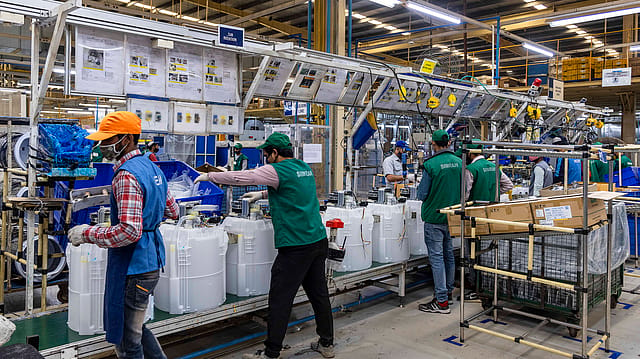Factory output steady in May amid high inflation
ADVERTISEMENT

India's manufacturing sector growth steadied in May, with new orders and production increasing at similar rates to those registered in April, a monthly survey showed on Wednesday.
The seasonally adjusted S&P Global India Manufacturing Purchasing Managers' Index (PMI) fell to 54.6 in May, little-changed from 54.7 in April, pointing to a sustained recovery across the sector.
A PMI reading of more than 50 indicates expansion in activity, whereas that below 50 shows contraction.
The above-50 reading was the eleventh in as many months and consistent with a solid improvement in operating conditions.
Companies were able to secure new work despite lifting selling prices at the fastest rate in over eight-and-a-half years as additional cost burdens continued to be transferred to clients, the survey says.
Total sales were boosted by a substantial upturn in international orders, the strongest in over 11 years. "May data also highlighted a notable uptick in growth of new export orders. The rate of expansion was sharp and the fastest since April 2011," the survey adds.
"India's manufacturing sector sustained strong growth momentum in May. Thanks in part to the sharpest rise in international sales for eleven years, total new orders expanded further. In response to demand resilience, companies continued with their efforts to rebuild stocks and hired extra workers accordingly," says Pollyanna De Lima, economics associate director at S&P Global Market Intelligence.
December 2025
The annual Fortune 500 India list, the definitive compendium of corporate performance, is out. This year, the cumulative revenue of the Fortune 500 India companies has breached $2 trillion for the first time. Plus, find out which are the Best B-schools in India.
"While firms appear to be focusing on the now, the survey's gauge of business optimism shows a sense of unease among manufacturers. The overall level of sentiment was the second-lowest seen for two years, with panellists generally expecting growth prospects to be harmed by acute price pressures," adds Lima.
Amid reports of new business gains, sustained improvements in demand and looser Covid-19 restrictions, manufacturers continued to scale up production in May.
Indian manufacturers signalled a further increase in output prices halfway through the first quarter of fiscal year 2022-23. "There was little-movement in the rate of input price inflation during May, which remains historically high, but output charge inflation surged to its highest in over eight-and-a-half years as companies continued to transfer additional cost burdens to their clients," says Lima.
Input costs rose for the twenty-second successive month in May, with companies reporting higher prices for electronic components, energy, freight, foodstuff, metals and textiles.
Manufacturing sector jobs rose further in May, owing to ongoing improvements in sales. Although only slight, the rate of employment growth picked up to the strongest since January 2020, the survey notes. Goods producers stepped up input purchasing in May, thereby stretching the current sequence of expansion to 11 months, it adds.
